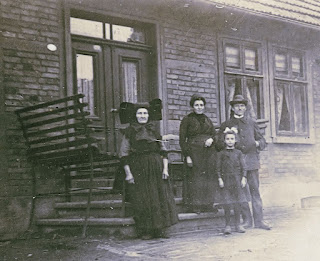Every picture tells a story No. 26
Ernst Leopold the steel worker had at least seven brothers and sisters, and his three sons had around a dozen cousins. One of the brothers was Friedrich with the fiddle. Another, Albert Kosmowski, was a forester's assistant at Forsthaus Gottesgnade, Sangnitten, Kreis Preussisch Eylau, East Prussia. He was working for the Baron von Stegen.
Here he is hiding in the shadow of his forester's hat, with his wife Auguste next to him. The children are, left to right: Hilde, Emmi, Fritz, Lieselotte (a visiting niece from Allenburg, daughter of his brother Franz), and Charlotte:
Charlotte was born in 1919, so I concluded the photo might date from the mid or late 1930s. I'm getting the feeling that the looks on their faces get grumpier in direct proportionality to their ages, so that may reflect the dark times, looming war, etc., of which the younger children were blissfully unaware. I might follow Charlotte's tracks in a later entry.
We'll have to talk about the poor old animal in this picture too. At first glance, I had naively assumed that the family was posing with an antler serving as decoration on some sort of garden (or forest) furniture. As you would if you were a town mouse visiting some rustic forester's hut today. Then I found this other photo, with the same setup, minus the family:
So the story is he shot the stag and then gathered round the whole family plus a visiting niece to pose with it. Oh well. This one is dated 1941 (on the back, not sure by whom), so I guess the good news is that at this point in history Albert was allowed to stay at home shooting game as opposed to going to war and shooting people.
UPDATE 26.4.2025: I found Albert's death notice (on page 18 of this pdf file) and thus the married names of his daughters, as of 1974, namely Charlotte Steen and Hilde Pukis. Heinz Kosmowski is also named (so the identification of the boy in the stag photo as "Fritz" may have been an error), but Albert's grandchildren and great-grandchildren are only referred to collectively. In contrast to my inlaws, this family appears to have used the spelling with the i at the end, so I'm correcting that in the mentions above. The youngest girl, Emmi appears to have died before 1974. Albert died on 22.9.1974 aged 80.
This photo is also on flickr.
Every picture tells a story series so far:
- string quartet Wuppertal Elberfeld 1927
- greetings from Adamsweiler
- Gastwirthschaft Ferd. Weirich
- quartet times three
- Neumühl 1923
- Tangermünde railway station 1889
- a singing lesson
- bei Wilhelm Geppert
- a bakery at Lorsch 1900
- Consumgeschäft von Julius Düsselmann
- Hanna and Ruth
- a young chemist
- school's out at Reichenstein, 1886
- a patchwork family in East Prussia
- the case of the missing grandmother
- checkpoint Glaner Brücke 1929(ish)
- finding Mimi
- five sisters, five decades
- happy at home
- gone milking
- steel workers
- field work
- what to wear at Porta Westfalica
- a classic convertible
- at the bottom of the steps
Alternatively, you can use this twitter thread as an illustrated table of contents.
In a somewhat roundabout way, this series relates to my research for the family history music memoir I have now completed in a first version.






























